News from Haiti Vol. 8: Haiti's Cultural Features (part 3)
Religion in Haiti (Christianity and Voodoo)
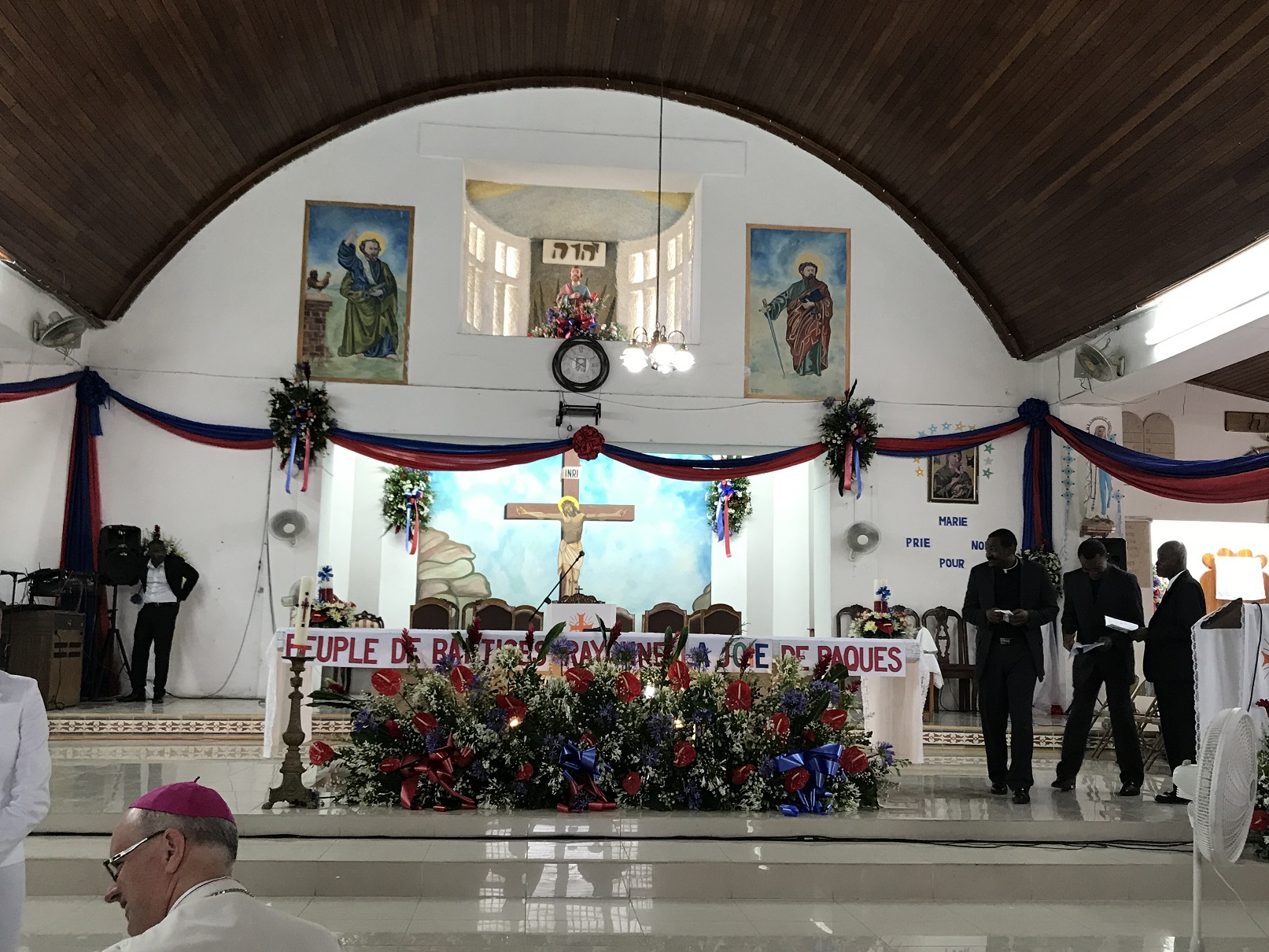
(Flag Day mass)
In this month’s column, I will be talking about Haiti’s religion in hopes to further deepen understanding about its history, culture, and society. I will not be talking about the philosophy of religion or politics in regards to religion, but only as it is connected to residents’ daily lives.
◆Religion in Haiti
(Current state of religion of Haiti)
In modern Haiti, Catholics and Protestants have penetrated the nation, with many devout believers. On the weekends large groups of people gather in front of churches; one can often see people in full formal dress taking part in weddings and funerals at churches.
Simultaneously, the Voodoo religion which draws from Haiti’s African ancestors has also taken a hold in society through various forms. Additionally, Islam and other religions do exist, and although their numbers are slowly increasing, they are hard to spot.
Putting theories aside, over 50% of Haiti’s population subscribe to Catholicism (some theories have it around 80%), Protestantism at around 30%, and although Voodoo may seem to be only a small percentage who practice Voodoo, in fact there are people who claim to be Catholic but who also practice Voodoo throughout their daily life.
(Historical transition)
In regards to Haiti’s historical background, various religions have not always peacefully coexisted, their relationships taking many twists and turns through the ages.
To give a broad and brief explanation, the flux of religions and their status has been great over the years, starting from before Haiti’s independence, when the native Taino peoples’ religion was the only religion. Catholic missionaries from Europe landed on the island and colonized the Taino and imported Catholicism. The numbers of Tainos decreased, and altogether disappeared, as did their religion. The spread of the folk religion ‘Voodoo’ brought along from African origins increased proportionately; after Haiti gained its independence, the favorably-treated Catholic religion conflicted with Voodoo, which was followed by the establishment of Protestantism on the island. In 1860 the Vatican was officially recognized by Haiti and established protection, subsequently placing pressure on the Voodoo religion (only one instance of many to come). It then took a turn to welcome the Voodoo religion, then hostility emerged between the Voodoo and Protestant religions. Most recently, Voodoo was recognized as an official religion in 2003.
(Related Laws & Regulations: Ministry of Worship)
Haiti’s current constitution demands the freedom of religion (2012 revision, article 30), along with related laws. Additionally, the Ministry of Worship was established as a regulatory agency, in charge of things such as registering religious corporations. On May 30th, 1924, the Ministry of Worship was set by law, and afterward fell under the administrative jurisdiction of the Ministry of Justice and then the Ministry of Education; in 1987 under the new constitution the Ministry of Worship was officially established and is now the Ministry of Foreign Affairs and Worship.
◆Christianity
(Catholicism)
Christianity, in particular Catholicism, was brought from Europe starting in the 15th century. It was first brought by the Spaniards, then French colonizers as well as others. Specifically, Christopher Columbus first landed on the Island of Hispaniola in the town of what is now Môle Saint Nicholas on December 6th, 1492 (named after St. Nicholas; St. Nicholas’ Day was December 6th) in what was called the Moustique Bay. Upon his landing it is said he constructed a large cross to mark his discovery. In 1983, Pope John Paul II visited Haiti and in his opening speech he made a reference to this, saying “It is almost 500 years since a cross was constructed on Haiti’s land…”.
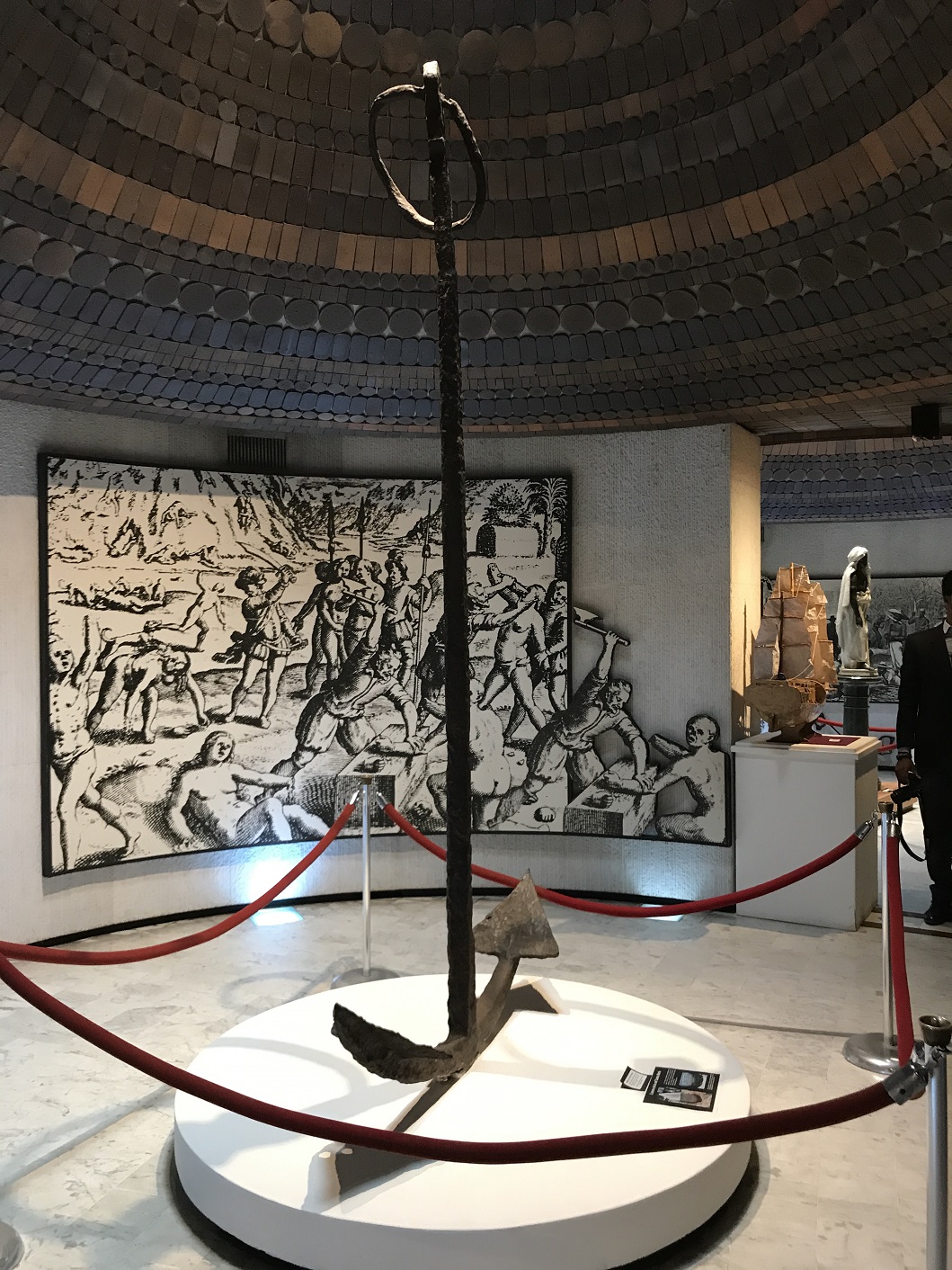
(Anchor from Columbus’ ship, the Santa Maria, belonging to and displayed at the Mupunah Museum)
Jean-Pierre Boyer became the President of Haiti in 1818 and during his presidency not only did he integrate the separated North and South, he even went so far as to integrated the neighboring Spanish territory (now the Dominican Republic). He even demanded to move the capital of Haiti, Port-au-Prince to where the Archdiocese was located in St. Domingo. However, this demand aroused ill feelings towards President Boyer in the Archdiocese, and although the Catholic Church tried time and time again to arrange a suitable situation for both parties, in the end no action took place.
Nevertheless, in 1824 there was a lot of hubbub when it was announced that the Vatican was going to approve the independence of Haiti. When Haiti fought for independence from its French colonizer, Haiti was required to pay compensation money in return for France to recognize it as a free nation (Haiti was fully recognized by France as independent in 1938). However, in 1824 there were little to no nations who recognized it as a sovereign state, and thus the Vatican’s decision to officially recognize Haiti as independent is a very significant act (America did not recognize Haiti’s sovereignty until 1862 under President Lincoln).
Afterward, an official concordat between the Pope and Haiti was established under Pope Pius X and President Fabre Geffrard on March 28th 1860; this was intended to officially rule and structure the relations between the Vatican and Haiti. This concordat gave Haitian presidents the right to nominate the appointments of Archbishop and Bishop, but it is said that the only president to use this power was François Duvalier; however, his son and future president Jean-Claude Duvalier abandoned such right. Pope John Paul II touched on this during his speech in Haiti on March 29th 1983, talking about the return of the power of appointment to the Pope. On August 8th, 1984 an agreement was made between Haiti and the Vatican where this was expressed in text.
Additionally, during his speech, the quote “something must change here” spoken by the Pope is said to have made a large influence in Haitian society.
(Christianity in everyday life)
Going along with tradition and history, Presidents and other important figures participate in Independence Day celebrations etc., are preceded with a Catholic Mass (Te Deum) before the official ceremony.
Another tradition involving Christianity is the Dean of the Diplomatic Corps; it is a longstanding tradition that the longest-serving member becomes the Dean of the Corps within some countries; however, as seen with other Latin-American nations, the diplomat who served as the Nonce Apostolique (papal nuncio, or diplomat of the Vatican) is automatically the Dean of the Diplomatic Corps here in Haiti.
The current President Moïse has traveled to the Vatican and met with Pope Francis, which shows Haiti's priority of Haiti’s relationship with the Catholic Church.
Also, it is not uncommon for priests and pastors to visit newly established schools, health centers, etc. in the villages where they give a prayer before the opening ceremony. When a new school or building has been erected, the priest (or pastor) will purify the building with holy water at the inauguration ceremony; it is in these simple ways that Christianity is a part of citizens’ daily lives.
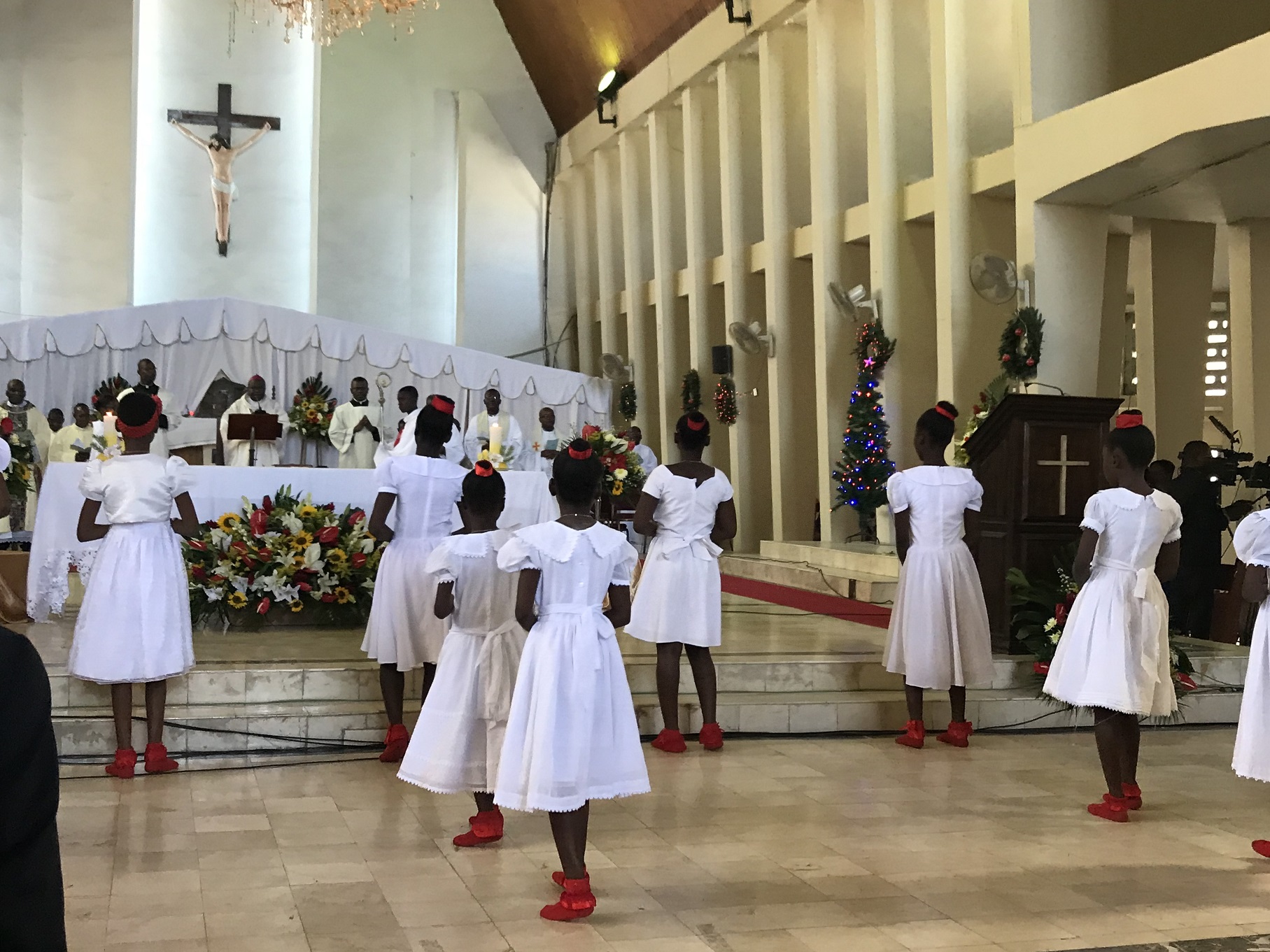
(Dance taking place at Haiti’s Independence Day Mass)
Protestant missionaries came to Haiti in 1816; the Quakers Etienne de Grellet du Mobilier (Stephen Grellet) and John Hancock were the first to arrive, landing in Les Cayes in the southwest of Haiti. Later on, when they paid a courtesy call to President Pétion, the President passed three conditions. Firstly, the first Pastor should not be French, secondly, the Protestant churches should not be involved in political issues, and thirdly Protestants should concentrate on education. Maybe because of this, 19% of elementary schools are of Protestant related compared to 10% Catholic.
Protestantism has many denominations and their activities are characterized by using the local language (Creole) and radio stations to spread their message.
◆Voodoo
Haiti also has its own unique religion, Voodoo (also Vodou, Vaudou in French). Voodoo is found not only in Haiti, but originated in the Kingdom of Dahomey (currently Benin, West Africa), as well as in Toga, and a version derived from it in New Orleans in the United States also exists. There is no doubt that the Voodoo practiced in Haiti today has its own unique characteristics and gives characteristics to Haiti. It is said that the word Voodoo originates from the Dahomey Kingdom’s Fon people’s word Vodun, meaning spirit or god, and traveled across the ocean to Haiti over 200 years ago. People from different areas and different religions slowly came together, mixing with the Taino’s customs and beliefs, and later on integrating many practices of Catholicism (syncretic is often used to describe the relationship between Voodoo and Christianity) to create Haiti’s unique Voodoo religion.
When hearing the word Voodoo, especially for Japanese, some might foster a frightening, magical image; these kinds of images may have spread after the U.S.’s occupation in Haiti, amplified in movies and books probably due to the increase of using this image of Voodoo such as Zombies and magic, and even further, zombies started to walk by themselves within lots of Hollywood movies . In the 1973 James Bond movie “Live and Let Die”, Voodoo was depicted in such a distorted way that it is believable that the depiction spread the mystical image of Voodoo. This image is hard to wipe away, and it is not necessarily known to what degree Voodoo is believed in, and what sorts of practices it has; also that Voodoo and Haiti are connected.
It is said that in order to gain independence, the slaves responsible for starting the insurrection against the French colonizers gathered in the “Bois-Caiman” forest and held a Voodoo ceremony where they swore to be liberated, called the “Ceremony of Bois-Caiman”. Additionally, the leader responsible for this unifying role is said to be a Houngan (male Voodoo priest) named Boukman. Stories such as this make Voodoo a part of the identity and cornerstone for Haitians. It is not had to imagine that Voodoo has become a powerful existence for Haitians before and after gaining sovereignty due to their challenging living and social environments.
However, going back to around the time of Haiti’s independence, both the 1801 and 1804 Constitutions did not include Voodoo as an official religion of the State.
Much later in the 1970’s, there was a time when the famous Haitian dictator President Papa Doc (François Duvalier) used Voodoo improperly for political reasons.
In addition, on September 5th 1935 a strict ordinance was passed outlawing superstitious practices (this was pointing directly at Voodoo), punishing anyone who disobeyed and confiscating all related materials. Historically Voodoo has gone through hardships on its way to present day.
In contrast, in the 297th article of the 1987 Constitution, the above ordinance of 1935 was removed and made that all laws criminalizing Voodoo were no longer effective.
In 2003 President Aristide enacted a Presidential Ordinance which gave Voodoo official religious status. According to same ordinance clause two, all Supreme Leaders, those responsible for temples and holy sites, leaders of systems and organizations were able to be recognized by the Ministry of Worship. Additionally, according to the fifth clause, Supreme Leaders and those responsible for temples and holy sites, who have taken an official oath in civil courts are allowed to perform baptisms, weddings, and funerals. In the beginning paragraphs of the 2003 Presidential Ordinance, it states that Voodoo is the religion of Haiti’s ancestors and is one fundamental element of Haiti’s identity.
Furthermore, in the 2012 Constitutional revision, the 29th tenet of the 1987 Constitution was removed, spurring backlash from Voodoo religious leaders saying that the constitutional rights of Voodoo were in regression.
(The Supreme Leader)
In September 2015, the Supreme Leader of the Voodoo religion in Haiti (called Ati in Creole), Max Beauvoir passed away. The interim Supreme Leader Auguste St. Clous was named; following his appointment to the position, the National Confederation of Haitian Voodooisants (KNVA) unanimously elected Joseph Fritzner Comas to the position of National Ati, where he continues to serve as Supreme Leader while Auguste St.Clous became claimed King of Voodoo and both are existing now..
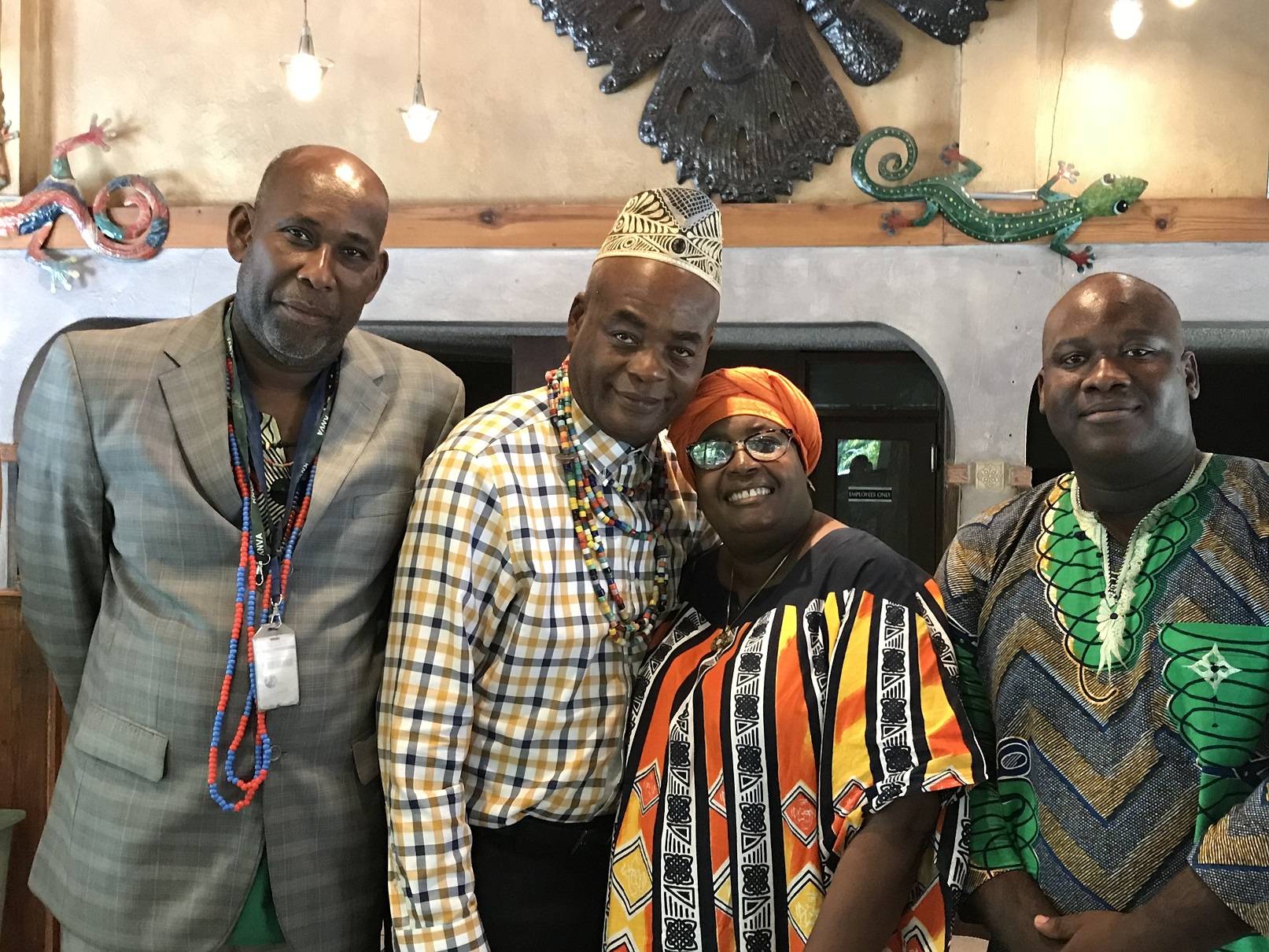
(National Voodoo Ati and KNVA leaders)
When looking at Voodoo in terms of structure, it has a relatively relaxed side. There is no definite, hierarchical pyramid corresponding with stringent nominations and designations of powerful positions; the ordination of priests is also flexible. There is no sacred religious document equating to the Bible or Koran; it is a calm religion focused on listening to the truths of nature. However, the positions of Supreme Leader (Ati), King (Roi), and Emperor (Empereur) also exist in Voodoo.
Many Voodoo tales and traditions have been passed down orally from generation to generation, making belief an element, but it is also part of daily life and Haitian culture. Formerly, before there was a formal law governing society, Voodoo’s Supreme Leader played the role of conciliator in disputes and quarrels, gave wisdom, brewed medicinal herbs for those who were sick, and brought people back to health both physically and mentally. Additionally, there is no gender gap in Voodoo, with same-sex relationships accepted, giving everyone a place of belonging.
Voodoo is a religion which places importance on nature and its ancestors, also equally respecting the spirits, communicating with them to try and find relief and comfort. Thus it is said that believers treasure nature and lament the destruction of Haiti’s woods, restoring these forests and maintaining and protecting Haiti’s nature.
The priest who is in charge of administrating religious services in the community is called a Houngan for men, and a Mambo for women, and Voodoo society (Société) is comprised of groups who support these priests. Furthermore, through these religious services different Houngan and Mambo societies socialize together; the invited party must abide by the rules and customs of the hosting society’s priest. Also, there is a separate ‘organization’ that functionally transverses the religion.
Houngan priests hold a social and cultural position in society; another duty they must perform is holding religious services for a total of 401 Lwa Voodoo spirits.
According to answers given to me by voodooists, it is common among the societies of voodoo to strengthen the foundation of Voodoo by improving the education and history of the religion, as well as building a head temple of worship for all Voodoo societies called Badji.
(About Lwa)
Voodoo uses the word “spirit” in place of “god”, and the Lwa spirits are at the center of this belief; interestingly, however, in many cases the Catholic Saints and Voodoo spirits have a corresponding relationship. This is said to have happened over time as a way to save Voodoo from disappearing.
Looking at a small fraction of the Lwa (for the sake of brevity), there are large differences between the birthplace of the Lwa. For example the Rada come from the Dahomey Kingdom in Africa; Kongo come from the Republic of the Congo, and Petro, the newest of the Lwa are Haitian, comprising the three lineages of Lwa.
Another interesting things is that the Lwa all have different personalities (jealous, aggressive, sad etc.), I may say something , similar to that of the Ancient Greek gods. Thus there is a custom of giving different offerings to each spirit based on their personalities.
For example, in the Rada lineage, Legba is the intersectional guardian spirit, connecting the spirit world and the human world, corresponding to the Catholic saint, St. Pierre. Legba is an old man who hold a key in his right hand, and in his left hand holds a book. Legba is the first Lwa to be summoned during a Voodoo ceremony because he is the spirit that opens up the door separating the human and spirit worlds. The female representative of the Lwa is Elzulie Freda who symbolizes love, beauty, and jewels. La Silene is the siren (mermaid) and exists inboth male and female sirens. Also, Ogoun is the spirit of war who has different variations; Ogoun Ferei (Féraille) is the spirit of iron and sabers, who equates to the Catholic saint St. Jacques Le Majeur. Ogoun Ferei is a warrior who rides a white horse, and a painting of this hangs in the Péristyle. Additionally, Guedé are a family of spirits who represent death and the world after death; Baron Samedi is the representative spirit guarding the entrance to the graveyard.
In contrast, the Petro are native Haitian spirits and are seemingly described as slightly short-tempered. For example, Kalfu (Carrefour) is the Petro verson of Legba, and its name is the same name as the Cross (based on the French language). There is also a spirit similar to Elzulie in Petro called Elzuli Dantor, who symbolizes strong women and motherhood.
There are many more Lwa’s in Voodoo, but I will stop short of describing all of them.
(Voodoo rituals: ceremonies)
Voodoo priests and priestesses perform religious rituals in the Péristyle (a spacious room) in temples which are called Ounfò. In the center of the Péristyle is a Potomitan, meaning ‘center pillar’, having a pedestal as a base. Peristyle's floor is bare ground in most cases. When performing the ceremony, the religious symbol called Vévé (comprised of the Lwa to make a geometrical pattern) is drawn on the ground around the potomitan using flour and/or corn flour, and candles are lit. The attendees of the ceremony gather around the priest (priestess) where they dance and chant prayers to each Lwa to the rhythm of the drums. The dancing and chanting make some of the attendees fall into a trance, and the spirits that were summoned during the ceremony use the potomitan to transfer themselves to a Choual (horse) where they communicate with the human world .
Although slightly different from the music used in Voodoo ceremonies at temples and other holy places (ponds, waterfalls, forests, etc.), the rhythm of the drums and dance has been designated as Haitian folk dance (folklore) and music.
During the period between Lent and Easter there is a custom where a Voodoo-related band called Rara performs a procession.
Voodoo is for the most part a peaceful religion; however, a small fraction uses magical rituals; the priests of this faction are called Bokor and are separate from the Houngan and Mambo.
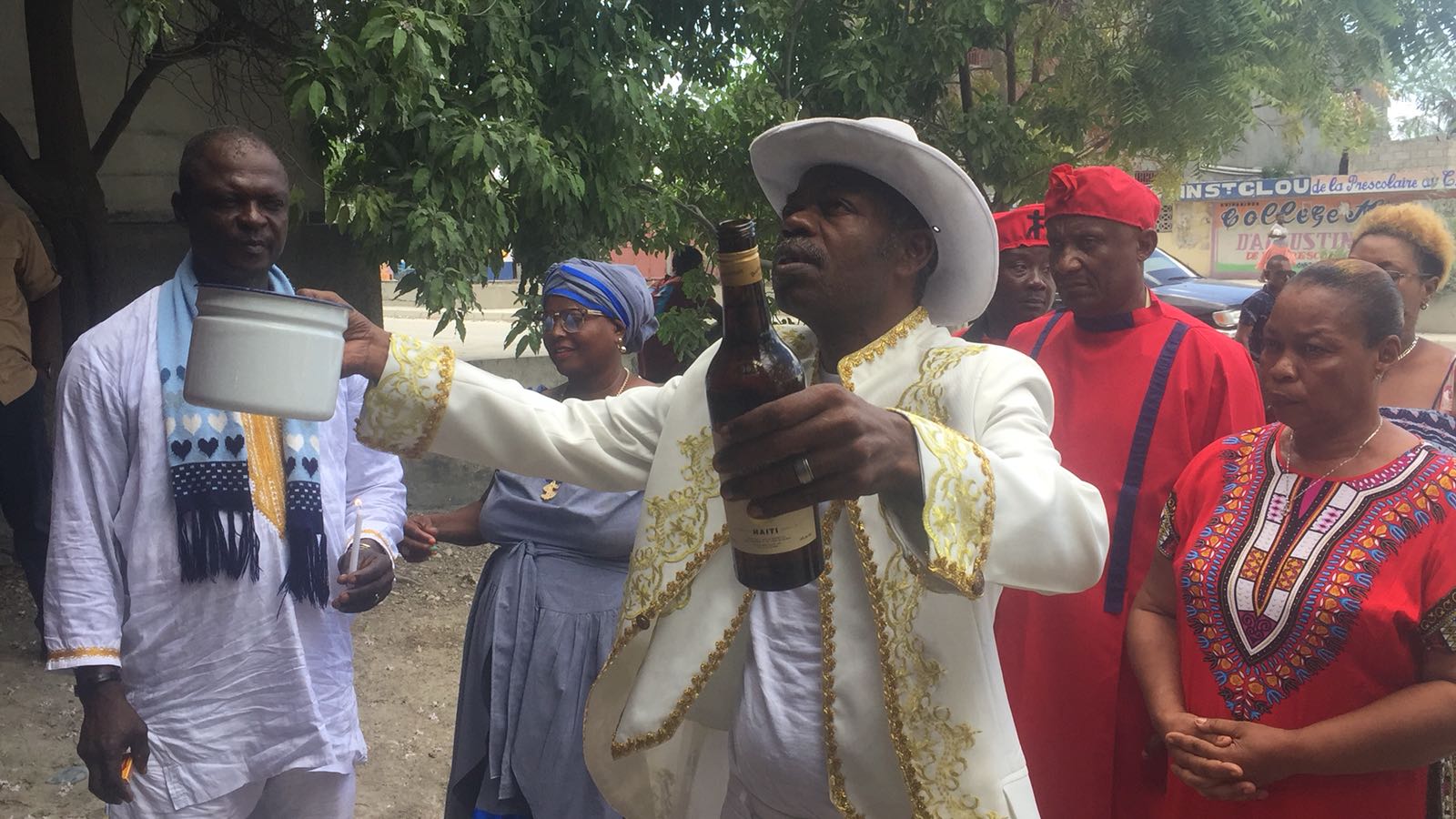
(Christening in front of Ounfò: water and rum)
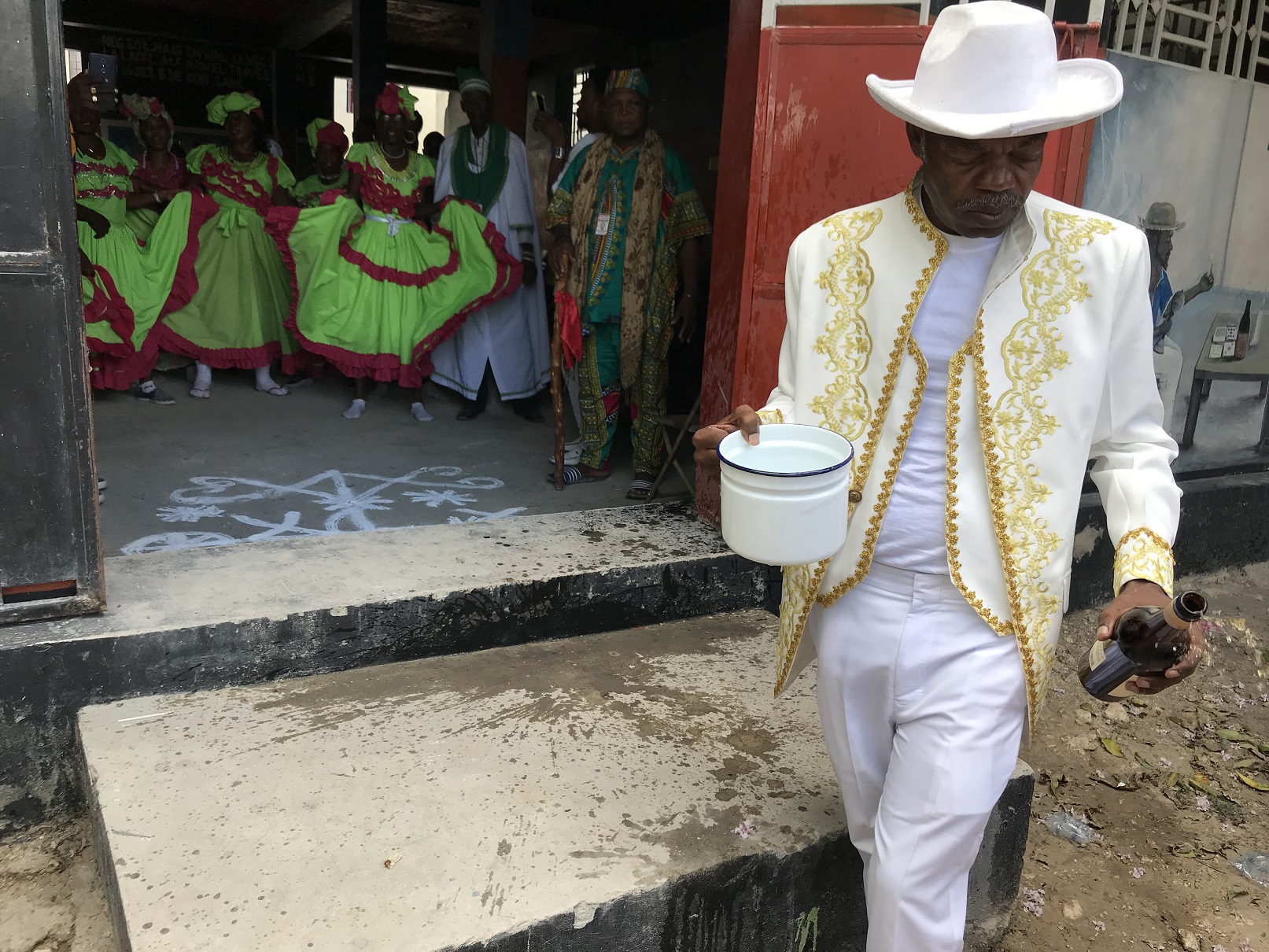
(Christening in front of Ounfò: sprinkling rum)
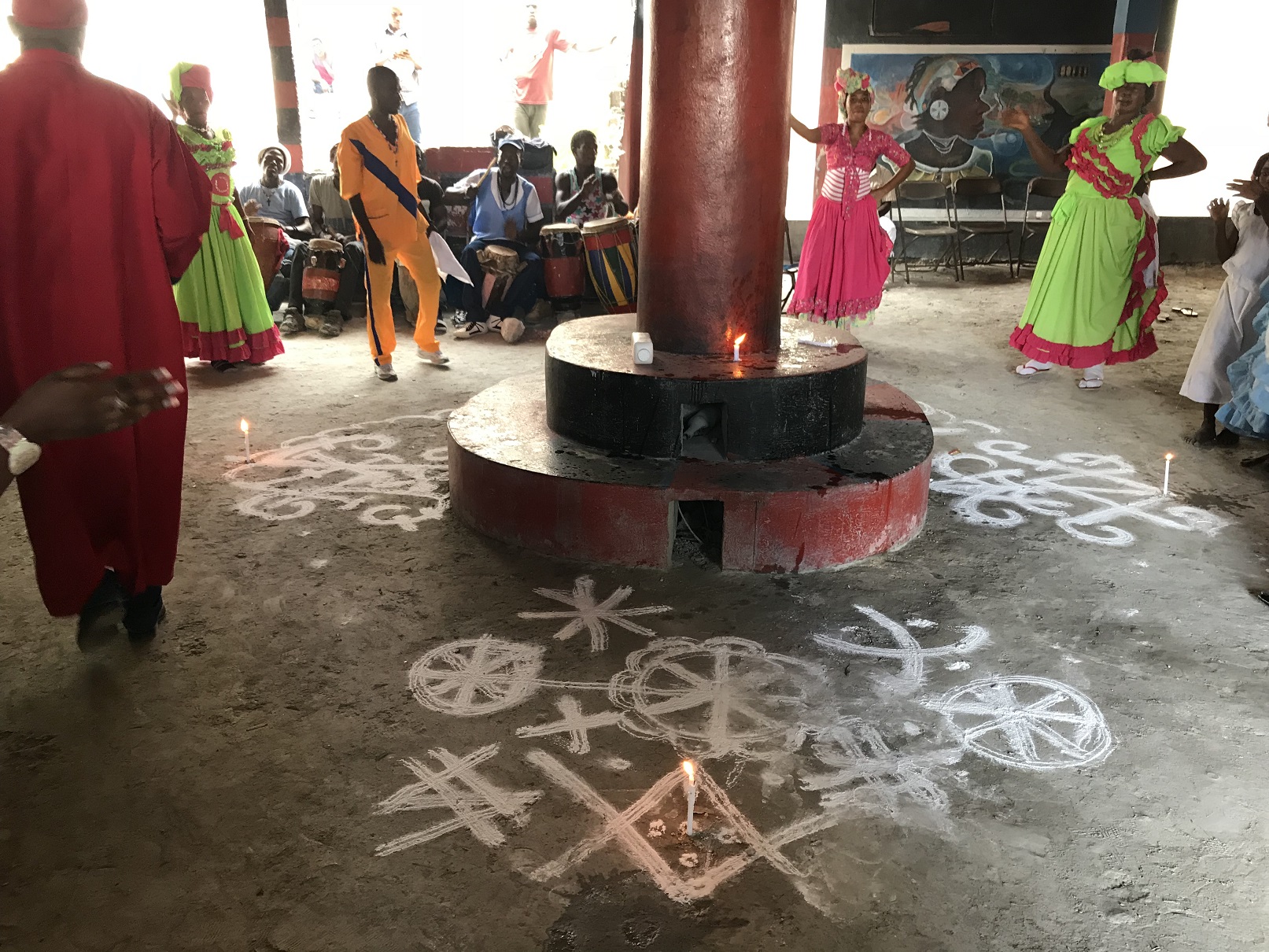
(Inside the Voodoo Péristyle: Potomitan in the center and a Vévé drawing on the ground)
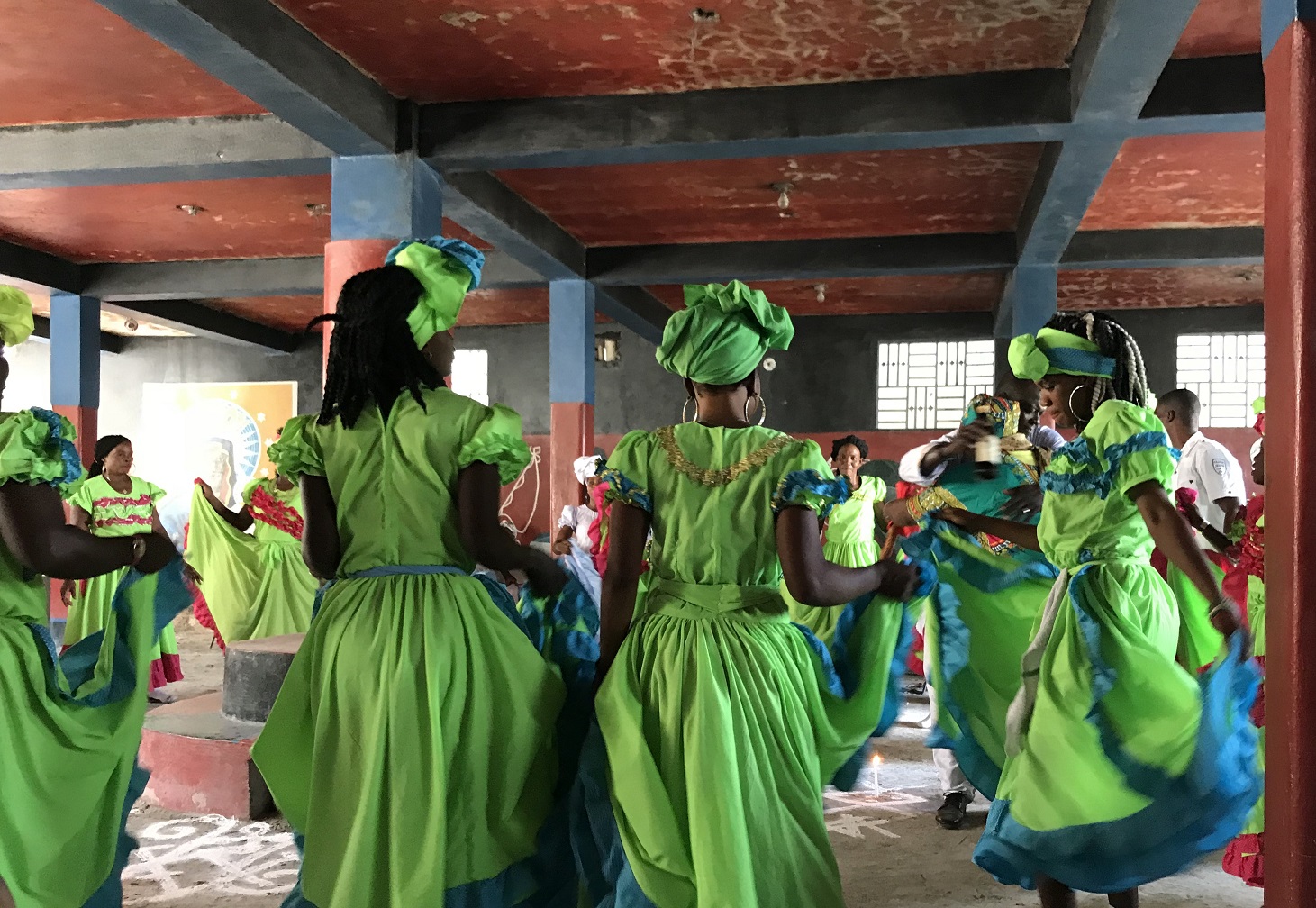
(Voodoo prayer dance)
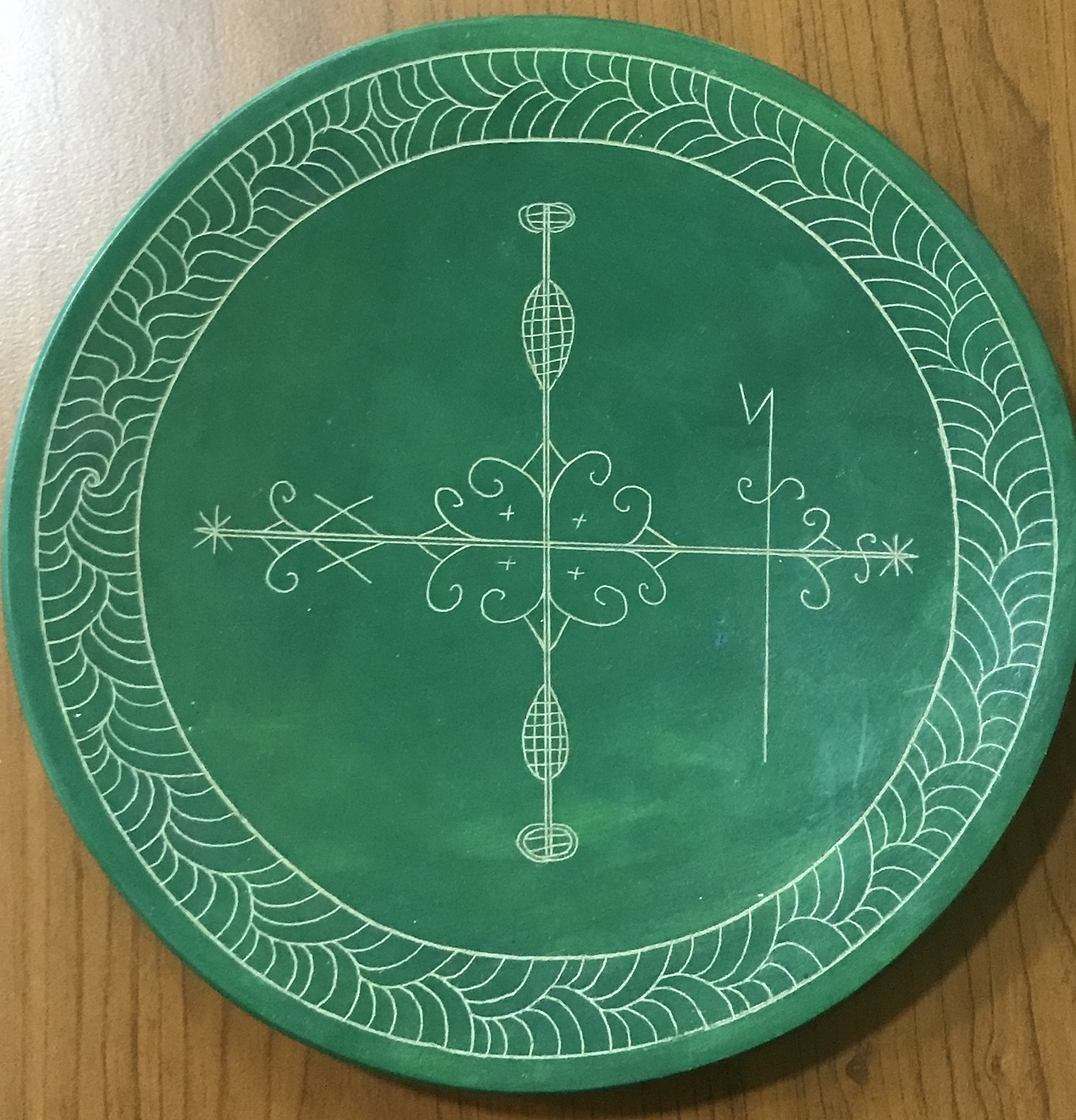
(Decorative plate with the Vévé design)
The zombies that are depicted in numerous movies and books seem to have their roots in Haiti Voodoo, but it seems that the depictions differ. In Haitian Voodoo, zombies are not corpses that have come back to life, but are actually living people that have been put into a temporary state of death by using a “zombie powder”. Although this is not the popular story of zombies, it is said that there are people who perform “zombification”. I asked why people would perform this ritual, and the response I gathered was to perform acts of retaliation on those who had wronged others. They also talked about using white powders from blowfish and others to make it look like a natural death.
There have been accounts recently where the Senate’s Safety Commission Chairman has tried to legally punish the fictionalization of zombies by incorporating it into the criminal law and putting it under the code of criminal procedure. Also, word on the streets is that more than if the above is true or not, there is an awareness that zombies have become an urban myth creating a sense of distrust and largely affecting the economy and society.
The associated image with ‘zombie’ has become so widespread that even a daily newspaper uses the term “zombie checks” to refer to checks with unknown sources linked to corrupt politicians and politics.
(Commonalities with Japanese religions)
After listening to the various descriptions of Voodoo, something starts to sound familiar. It is not necessary to directly compare Voodoo and Japanese Shintoism, but they both stem from the idea of respecting and cherishing nature, revering ancestors and valuing family. I was fortunate enough to speak with the Supreme Leader (Ati) and other Voodoo leaders where they told me that Voodoo is an approach to unknown circumstances and is a never-ending pursuit. They also explained that everything is born from the earth, and everything returns to the earth. An important element of Voodoo is listening to the forest; accepting people for who they are without discriminating and healing is the power of Voodoo, which not only contains mental and spiritual elements, but also is a part of everyday life, society, justice, medical care, and culture all wrapped in one.
This point of treating the forest as holy can be compared with Japanese temples and shrines which can commonly be found on mountains and forests. Just as the Voodoo religion has 401 spirits, it is said in Japan that there are eight million gods. The idea of karma, punishment, and the power of language are important in both Voodoo and Japanese Shintoism.
After my experiences learning about Haiti’s religious situation, I again felt that various wisdom and faith plays a complicated role for many people living in a harsh natural, economic, and social environment.
(*All photos taken by the author)
(*This column reflects the personal views of the author and not the opinions of their employer)
Back numbers are here
WHAT'S NEW
- 2024.12.4 UPDATE
PROJECTS
"Barbados A Walk Through History Part 14"
- 2024.9.17 UPDATE
PROJECTS
"Barbados A Walk Through History Part 13"
- 2024.7.30 UPDATE
EVENTS
"408th Lecture Meeting Regarding Global Issues"
- 2024.7.23 UPDATE
PROJECTS
"Barbados A Walk Through History Part 12"
- 2024.7.9 UPDATE
ABOUT
"GREETINGS FROM THE PRESIDENT JULY 2024"
- 2024.7.4 UPDATE
EVENTS
"APIC Supports 2024 Japanese Speech Contest in Jamaica"
- 2024.6.27 UPDATE
EVENTS
"407th Lecture Meeting Regarding Global Issues"
- 2024.5.21 UPDATE
EVENTS
"406th Lecture Meeting Regarding Global Issues"
- 2024.5.14 UPDATE
EVENTS
"405th Lecture Meeting Regarding Global Issues"
- 2024.4.2 UPDATE
PROJECTS
"Water Tanks Donated to Island of Wonei, Chuuk, FSM"




